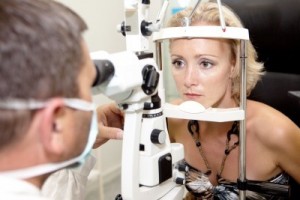Sponsored Ad
You Don’t Have to Already Have Type 2 Diabetes to Suffer Eye Damage
U.S. Department of Health and Human Services
NIH News | Release Date: June 12, 2005
 Diabetic retinopathy has been found in nearly 8 percent of pre-diabetic participants in the Diabetes Prevention Program (DPP), according to a report presented today at the American Diabetes Association’s 65th Annual Scientific Sessions. Diabetic retinopathy, which can lead to vision loss, was also seen in 12 percent of participants with type 2 diabetes who developed diabetes during the DPP. No other long-term study has evaluated retinopathy in a population so carefully examined for the presence or development of type 2 diabetes.
Diabetic retinopathy has been found in nearly 8 percent of pre-diabetic participants in the Diabetes Prevention Program (DPP), according to a report presented today at the American Diabetes Association’s 65th Annual Scientific Sessions. Diabetic retinopathy, which can lead to vision loss, was also seen in 12 percent of participants with type 2 diabetes who developed diabetes during the DPP. No other long-term study has evaluated retinopathy in a population so carefully examined for the presence or development of type 2 diabetes.
“These findings reinforce the recommendation that patients with newly diagnosed type 2 diabetes should be screened for retinopathy,†said Emily Chew, M.D., of the National Eye Institute, part of the National Institutes of Health (NIH) under the U.S. Department of Health and Human Services, which funded the study. “We advise good control of blood glucose, blood pressure, and cholesterol as well as regular eye exams.â€
“Previous studies have not accurately defined when type 2 diabetes begins, so our understanding of the onset of diabetic eye disease has been limited. Now we know that diabetic retinopathy does occur in pre-diabetes. We’re also seeing it early in the course of diabetes — within an average of 3 years after diagnosis,†noted Richard Hamman, M.D., DrPH, professor and chair, Department of Preventive Medicine and Biometrics, University of Colorado School of Medicine, and vice chair of the DPP. “This adds to our understanding of the development of retinopathy and suggests that changes in the eye may be starting earlier and at lower glucose levels than we previously thought.â€
Pre-diabetes is a condition in which blood glucose levels are higher than normal but not high enough for a diagnosis of diabetes. The condition is sometimes called “impaired fasting glucose (IFG)” or “impaired glucose tolerance (IGT),” depending on the test used to diagnose it. People with pre-diabetes have an increased risk of developing type 2 diabetes, heart disease, and stroke.
Diabetic retinopathy, which begins with changes in the small vessels in the back of the eye, often leads to loss of vision. Regular eye examinations to diagnose retinopathy are recommended for patients with diabetes because treatment with laser photocoagulation can often prevent blindness in more advanced cases. Diabetic retinopathy is still the most common cause of blindness in adults. (For more information about diabetic retinopathy, see NEI’s Diabetic Retinopathy: What you should know http://www.nei.nih.gov/health/diabetic/retinopathy.asp).
“Certain retinopathy lesions are considered indicative of the presence of diabetes because they are the first retinal changes to develop in this disease,†explained Dr. Hamman. “Although the retinopathy seen in the DPP participants was at a very early stage and did not affect vision, eye changes typical for diabetes were found in 8 percent of our study population before they developed diabetes. These observations may lead diabetes experts to reconsider the diagnostic thresholds used to define diabetes, which are based on levels of blood glucose associated with the development of eye, nerve and kidney complications of diabetes.â€
DPP study chair David Nathan, M.D., of Massachusetts General Hospital, pointed out that the retinopathy results are based on a random sample of only 12 percent of DPP participants, all of whom had impaired glucose tolerance, a form of pre-diabetes, when the study began. “These initial findings confirm what other studies have suggested. The complications of diabetes may begin before diabetes is diagnosed, at least by the current-day standards,†he explained. “Ideally, an expanded study of the remaining 88 percent of DPP Outcome Study participants might enable us to define more appropriate diagnostic thresholds.â€
About 18.2 million Americans have diabetes, a group of serious diseases marked by high blood glucose levels that result from defects in the body’s ability to produce and/or use insulin. Diabetes can lead to severely debilitating or fatal complications, such as heart disease, blindness, kidney disease, and amputations. It is the fifth leading cause of death by disease in the United States. Type 2 diabetes, which accounts for up to 95 percent of all diabetes cases, involves insulin resistance — the body’s inability to properly use its own insulin. It usually occurs in overweight adults, but it has increasingly been seen in obese children and teens in recent years.
About 40 percent of U.S. adults ages 40 to 74 — 41 million people — have abnormal blood glucose levels without having diabetes. Many will develop type 2 diabetes in the next 10 years. (In the DPP, about 10 percent of participants in the placebo group developed diabetes each year.) Once a person has type 2 diabetes, the risk of heart and blood vessel disease is 2 to 4 times that of people without diabetes.
Diabetes Prevention Program
The Diabetes Prevention Program was a major clinical trial in 3,234 people with impaired glucose tolerance. The study’s main results were announced in 2001 and reported in the Feb. 7, 2002 issue of the New England Journal of Medicine: Losing 5 to 7 percent of body weight through diet and a modest, consistent increase in physical activity (e.g., walking 5 days a week 30 minutes a day) lowered the incidence of type 2 diabetes by 58 percent. Treatment with metformin, an oral drug commonly used to treat diabetes, reduced the chances of developing diabetes by 31 percent.
The DPP was sponsored by the National Institute of Diabetes and Digestive and Kidney Diseases (NIDDK) and co-funded by other components of the NIH, the Centers for Disease Control and Prevention, and the Indian Health Service. The American Diabetes Association provided additional funding. Sources of corporate support included Bristol-Myers Squibb, Parke-Davis, Merck and Company, Merck Medco, Hoechst Marion Roussel, Sankyo, Lifescan, Lipha Pharmaceuticals, Slimfast, Nike, and Health-O-Meter.
About 90 percent of DPP participants continue to be followed closely in the DPP Outcomes Study to examine the longer-term impact of the original treatment interventions. All participants are given access to quarterly lifestyle group sessions, while those in the original intensive lifestyle group have access to additional lifestyle activities to help them stay on track. The participants originally assigned to metformin therapy continue to have access to the drug.
Retinopathy Findings
Three hundred two, or about 12 percent, of the DPP Outcome Study participants who had not developed diabetes during the study, and 588 of 876 participants who had developed diabetes, were selected to participate in the retinopathy study, funded by the NEI. To detect diabetic retinopathy, an evaluation of the fundus (inner lining of the eye) was performed with a special camera that provides a detailed look at the retina. Small changes in the vessels, called microaneurysms and hemorrhages, signal the development and degree of retinopathy severity.
Participants with pre-diabetes and retinopathy typically had a small number of microaneurysms in the eye characteristic of early, mild retinopathy that is not yet linked to vision loss. Those who had developed diabetes in the previous 1 to 5 years had slightly more severe retinopathy. Higher average blood glucose levels and higher blood pressure were associated with the risk of developing retinopathy in the new-onset diabetic patients, similar to previous findings in people with longstanding diabetes who develop retinopathy.
In its “Be Smart About Your Heart: Control the ABCs of Diabetes” campaign, the National Diabetes Education Program (NDEP) (www.ndep.nih.gov/), jointly sponsored by the NIH, the Centers for Disease Control and Prevention, and 200 partner organizations including the American Diabetes Association (ADA), encourages people with diabetes to control their blood glucose as well as their blood pressure and cholesterol. By keeping all three as close to normal as possible, people with diabetes can live long, healthy lives.
NDEP’s “Small Steps. Big Rewards. Prevent Type 2 Diabetes†campaign gives tips on lifestyle changes to prevent or delay type 2 diabetes.
“Make the Link! Diabetes, Heart Disease and Stroke,†is a joint initiative of the American Diabetes Association (www.diabetes.org/makethelink) and the American College of Cardiology (www.acc.org), which works to increase awareness of the link between diabetes and heart disease and help educate physicians and people with diabetes about how to reduce those risks.
The National Institutes of Health (NIH) — The Nation’s Medical Research Agency — is comprised of 27 Institutes and Centers and is a component of the U. S. Department of Health and Human Services. It is the primary Federal agency for conducting and supporting basic, clinical, and translational medical research, and investigates the causes, treatments, and cures for both common and rare diseases. For more information about NIH and its programs, visit www.nih.gov.




